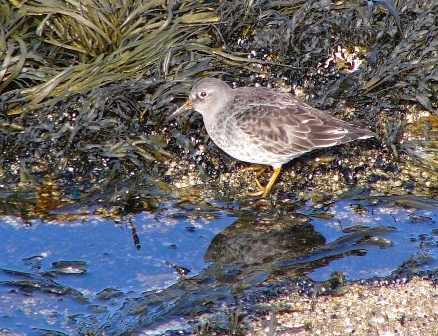 We have turned the seasonal corner. The swallows are gone, the egrets have fled, and shorebirds and warblers have pushed their way south. You may well ask, “What do we do we look for now?”
We have turned the seasonal corner. The swallows are gone, the egrets have fled, and shorebirds and warblers have pushed their way south. You may well ask, “What do we do we look for now?”
In many ways, Massachusetts is perfectly suited for winter birding, thanks in part to our remarkable landscape. We have sandy beaches, mountains, ponds, lakes, rivers, swamps, marshes, bogs, forests of different kinds, moorlands, grasslands, urban parks, and so much more.
We are primed to attract—and provide food and shelter for—dozens of species of birds. Here are just a few to look for.
Fall and Winter Birding Checklist
- Ducks. Look for greater and lesser scaups, buffleheads, and ring-necked ducks. Western prairie pothole ducks like redheads and canvasbacks can be found on ponds. The ocean is home to three species of scoter (surf, white-winged, and black) as well as horned and red-necked grebes, long-tailed ducks, and common goldeneyes.
- Purple sandpiper. The first of November usually heralds their arrival on the jetties and breakwaters.
- Snow buntings and horned larks. While seeking these out on the beach, look closely at their flocks: a Lapland longspur may be in the mix.
- Birds of prey. Recently cut grasslands exposes mice and voles, which attract northern harriers, rough-legged hawks, and even short-eared owls.
- Feeder area birds. You just never know when your house finches and tufted titmice are going to be joined by a red-breasted nuthatch or, better yet, a fox sparrow.
- Dark-eyed juncos and white-throated sparrows. These species come at us from two directions. Many of them slide down the map from the north, but others descend from breeding habitat in the western part of the state, up high on the mountains.
- Snowy owls. If you’re within striking distance of the beaches of the North Shore, South Shore, and Cape Cod, keep an eye out for the avian kings and queens of a Massachusetts winter. The species is irruptive, meaning it shows up seemingly randomly, in great numbers in some years, not at all in others.
- Alcids. And if you are at one of those beaches, don’t forget to look seaward for potential black guillemots, dovekies, murres, razorbills, and (if you’re extremely lucky) Atlantic puffins.
- Winter finches. Speaking of irruptions, nothing is as unpredictable as a “winter finch” invasion. This year, to date, we’ve seen crossbills, evening grosbeaks, and pine siskins in big flocks. Are the bohemian waxwings and common and hoary redpolls far behind?
Join us on an upcoming bird walk. You never know what you will see, but that’s half the fun! And do tell: What’s your favorite fall/winter bird?
Photo: purple sandpiper © Richard Johnson


I find this to be a fascinating minimalist time where I attend more carefully to what is there. Testerday I noticed the sounds of either a nuthatch or a brown creeper in the Easton ssection of Borderlands State Park.
fyi just in case you don’t already know about this and it might interest you and/or others you know – there’s a presentation by Dr. Dave Larson of Mass. Audubon on the “Birds of the Merrimack Valley” tonight (11/15) in Lawrence, sponsored by the Merrimack River Watershed Council – click on http://hosted.verticalresponse.com/325315/6af226229c/1432000109/c20914a7c8/ for more info.
I didn’t know half these birds existed! Would love to have accompanying photos for all the birds. But I will be keeping an eye out.